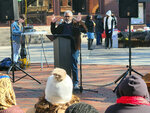‘Gravity of history’: Following Tubman’s path in 1996 was well worth trip
From the start of his journey May 4, 1996, Tony Cohen was struck by the enormity of it.
After extensive research on the Underground Railroad, he began a trek to follow it, starting in Sandy Spring.

You must be a member to read this story.
Join our family of readers for as little as $5 per month and support local, unbiased journalism.
Already a member? Log in to continue. Otherwise, follow the link below to join.
Please log in to continueNeed an account?
|
‘Gravity of history’: Following Tubman’s path in 1996 was well worth trip
SALISBURY, Md. — From the start of his journey May 4, 1996, Tony Cohen was struck by the enormity of it.
After extensive research on the Underground Railroad, he began a trek to follow it, starting in Sandy Spring.
Two months later, on July 7, the author and historian arrived in Ontario, Canada, after traveling north by foot, boat and rail.
The most impactful part of the quest, he said, was the first step of the 1,200 miles.
“The community and my family and friends came out to see me off, and it was a bittersweet moment,” the Germantown resident said. “I imagined how heart-rending it must have been for those to run for freedom, which they desired, (leaving) behind everyone they knew and loved.”
Mr. Cohen, now 60, added, “The other most impactful moment was reaching Niagara Falls, New York. I could only imagine the awe one must have felt coming all that way to cross the threshold of the powerful falls. It must have felt like a tribute or rite of passage to cross over to Canadian soil there.”
First traveled by Harriet Tubman upon her escape from slavery in 1846, the route came at a tremendous emotional cost, as she left her family in Dorchester County.
“I think people somewhat mistake her, by thinking that, when she escaped from slavery, it was a kind of repudiation from slavery,” Mr. Cohen said. Rather, “she escaped because she discovered she was about to be sold. So, the one thing she didn’t count on and never asked for and didn’t bargain for, but had to deal with when it was dropped in her lap, was that she self-excommunicated herself.”
Of course, the pioneer would return, several times. Eventually, she led dozens of slaves to freedom via the Underground Railroad journey Mr. Cohen re-created.
“I think Harriet Tubman’s impact has been as a proactive, positive symbol of unity and resistance,” he said. “She simply continues to inspire people to think about the state of the world.”
And, if she were alive today, he believes Ms. Tubman “would definitely be in some kind of social work. That was what her life was like.”
Outlining his background with the Underground Railroad, Mr. Cohen gave the keynote address at a Jan. 14 gathering to salute Ms. Tubman’s legacy in Salisbury. At the time, The Beacon of Hope statue featuring the abolitionist was situated nearby.
Before making his remarks, Mr. Cohen noted that “Harriet Tubman was a native of the Eastern Shore, so the achievements and things she was able to do came directly from the Eastern Shore, ... even though she came from a period of slavery and enslavement.
“I think people on the Eastern Shore can be proud of her because she helped turn the tide. She helped rewrite that history.”
Mr. Cohen, who founded The Menare Foundation, based in Germantown, to preserve the memory of the Underground Railroad and the thousands who traveled it to freedom, detailed his travel path as:
- Sandy Spring to Baltimore by foot.
- Baltimore to Wilmington, Delaware, by train.
- Wilmington to Chester and Lancaster counties in Pennsylvania by foot and Mennonite buggy.
- Philadelphia to New York City by train.
- New York City to Albany and Troy, New York, via U.S. 9.
- Through the Mohawk River Valley west through Utica, Syracuse, Auburn, Rochester, Niagara Falls and Buffalo, New York, where he crossed into Canada at Black Rock Landing by boat.
- He then drove back to Maryland after two weeks.
“In a number of places, I was actually led to or guided to or just fell in with people who were direct descendants of both freedom seekers and abolitionists who helped them, so I was able to kind of get close to the center of the gravity of history,” he said.
“But I was also just really kind of surprised that some of these people and communities that had this history still knew about it and revered it a century-and-a-half after it. That was kind of a surprise.”
Members and subscribers make this story possible.
You can help support non-partisan, community journalism.
Other items that may interest you







 By
By 



